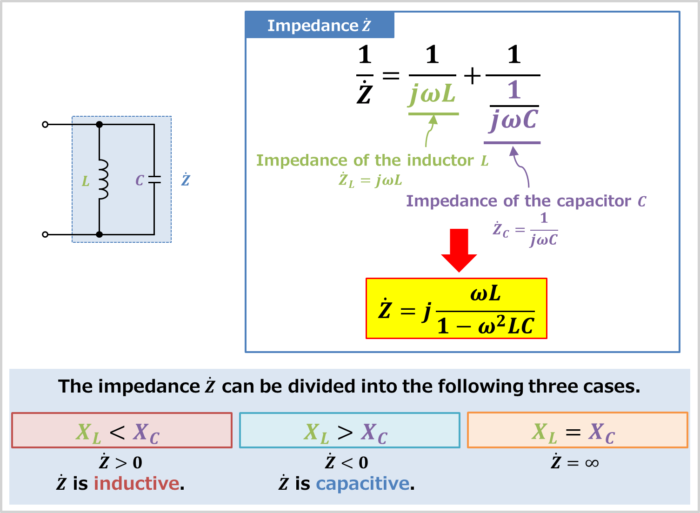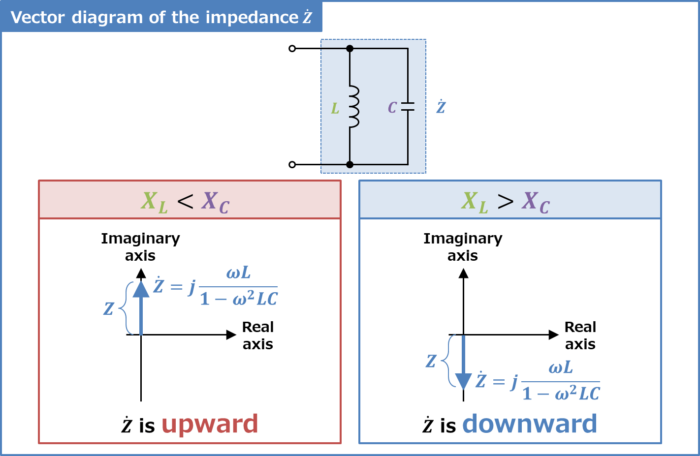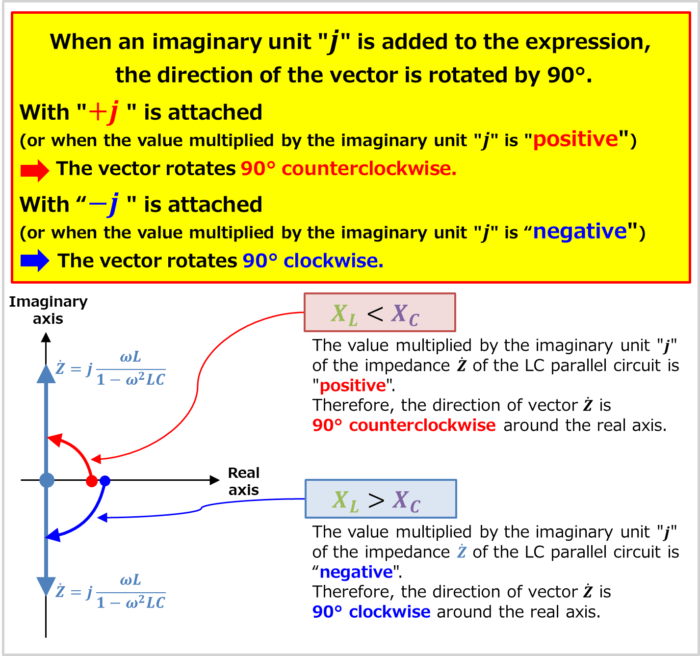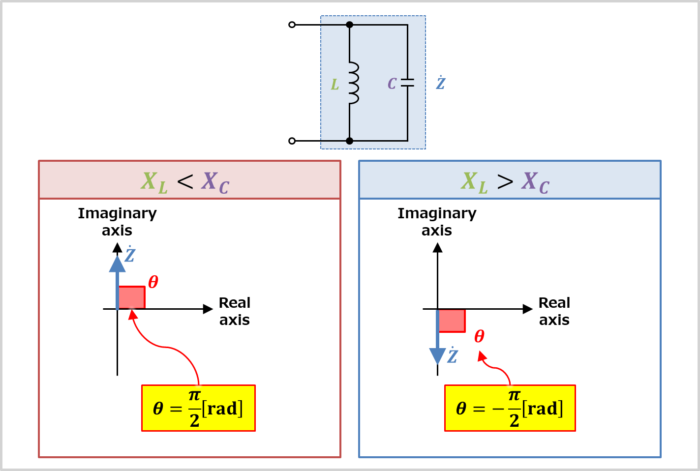Regarding the LC parallel circuit, this article will explain the information below.
- Equation, magnitude, vector diagram, and impedance phase angle of LC parallel circuit impedance
Impedance of the LC parallel circuit

An LC parallel circuit (also known as an LC filter or LC network) is an electrical circuit consisting of an inductor \(L\) and a capacitor \(C\) connected in parallel, driven by a voltage source or current source.
The impedance \({\dot{Z}}_L\) of the inductor \(L\) and the impedance \({\dot{Z}}_C\) of the capacitor \(C\) can be expressed by the following equations:
\begin{eqnarray}
{\dot{Z}}_L&=&jX_L=j{\omega}L\tag{1}\\
\\
{\dot{Z}}_C&=&-jX_C=-j\frac{1}{{\omega}C}=\frac{1}{j{\omega}C}\tag{2}
\end{eqnarray}
, where \({\omega}\) is the angular frequency, which is equal to \(2{\pi}f\), and \(X_L\left(={\omega}L\right)\) is called inductive reactance, which is the resistive component of inductor \(L\) and \(X_C\left(=\displaystyle\frac{1}{{\omega}C}\right)\) is called capacitive reactance, which is the resistive component of capacitor \(C\).
The sum of the reciprocals of each impedance is the reciprocal of the impedance \({\dot{Z}}\) of the LC parallel circuit. Therefore, it can be expressed by the following equation:
\begin{eqnarray}
\frac{1}{{\dot{Z}}}&=&\frac{1}{{\dot{Z}_L}}+\frac{1}{{\dot{Z}_C}}\\
\\
&=&\frac{1}{j{\omega}L}+\frac{1}{\displaystyle\frac{1}{j{\omega}C}}\\
\\
&=&\frac{1}{j{\omega}L}+j{\omega}C\\
\\
&=&\frac{1-{\omega}^2LC}{j{\omega}L}\tag{3}
\end{eqnarray}
From equation (3), by interchanging the denominator and numerator, the following equation is obtained:
\begin{eqnarray}
{\dot{Z}}=\frac{j{\omega}L}{1-{\omega}^2LC}=j\frac{{\omega}L}{1-{\omega}^2LC}\tag{4}
\end{eqnarray}
From the above, the impedance \({\dot{Z}}\) of the LC parallel circuit can be expressed as:
The impedance of the LC parallel circuit
\begin{eqnarray}
{\dot{Z}}=j\frac{{\omega}L}{1-{\omega}^2LC}\tag{5}
\end{eqnarray}
The magnitude of the inductive reactance \(X_L(={\omega}L)\) and capacitive reactance \(X_C\left(=\displaystyle\frac{1}{{\omega}C}\right)\) determine whether the impedance \({\dot{Z}}\) of the LC parallel circuit is inductive or capacitive.
- In the case of \(X_L{\;}{\lt}{\;}X_C\)
- In the case of \(X_L{\;}{\gt}{\;}X_C\)
- In the case of \(X_L=X_C\)
In the case of \(X_L{\;}{\lt}{\;}X_C\)
If the inductive reactance \(X_L\) is smaller than the capacitive reactance \(X_C\), the following equation holds.
\begin{eqnarray}
&&X_L{\;}{\lt}{\;}X_C\\
\\
{\Leftrightarrow}&&{\omega}L{\;}{\lt}{\;}\displaystyle\frac{1}{{\omega}C}\\
\\
{\Leftrightarrow}&&{\omega}^2LC{\;}{\lt}{\;}1\\
\\
{\Leftrightarrow}&&1-{\omega}^2LC{\;}{\gt}{\;}0\tag{6}
\end{eqnarray}
In this case, the imaginary part \(\displaystyle\frac{{\omega}L}{1-{\omega}^2LC}\) of the impedance \({\dot{Z}}\) of the LC parallel circuit becomes "positive" (in other words, the value multiplied by the imaginary unit "\(j\)" becomes "positive"), so the impedance \({\dot{Z}}\) is inductive.
In the case of \(X_L{\;}{\gt}{\;}X_C\)
If the inductive reactance \(X_L\) is bigger than the capacitive reactance \(X_C\), the following equation holds.
\begin{eqnarray}
&&X_L{\;}{\gt}{\;}X_C\\
\\
{\Leftrightarrow}&&{\omega}L{\;}{\gt}{\;}\displaystyle\frac{1}{{\omega}C}\\
\\
{\Leftrightarrow}&&{\omega}^2LC{\;}{\gt}{\;}1\\
\\
{\Leftrightarrow}&&1-{\omega}^2LC{\;}{\lt}{\;}0\tag{7}
\end{eqnarray}
In this case, the imaginary part \(\displaystyle\frac{{\omega}L}{1-{\omega}^2LC}\) of the impedance \({\dot{Z}}\) of the LC parallel circuit becomes "negative" (in other words, the value multiplied by the imaginary unit "\(j\)" becomes "negative"), so the impedance \({\dot{Z}}\) is capacitive.
In the case of \(X_L=X_C\)
If the inductive reactance is equal to the capacitive reactance, the following equation holds.
\begin{eqnarray}
&&X_L=X_C\\
\\
{\Leftrightarrow}&&{\omega}L=\displaystyle\frac{1}{{\omega}C}\\
\\
{\Leftrightarrow}&&{\omega}^2LC=1\\
\\
{\Leftrightarrow}&&1-{\omega}^2LC=0\tag{8}
\end{eqnarray}
In this case, the impedance \({\dot{Z}}\) of the LC parallel circuit is given by:
\begin{eqnarray}
{\dot{Z}}&=&j\frac{{\omega}L}{1-{\omega}^2LC}\\
\\
&=&j\frac{{\omega}L}{0}\\
\\
&=&∞\tag{9}
\end{eqnarray}
In this case, the circuit is in parallel resonance. When parallel resonance is established, the part of the parallel circuit between the inductor \(L\) and the capacitor \(C\) is open, and the angular frequency \({\omega}\) and frequency \(f\) are as follows:
\begin{eqnarray}
X_L&=&X_C\\
\\
{\omega}L&=&\frac{1}{{\omega}C}\\
\\
{\Leftrightarrow}{\omega}&=&\frac{1}{\displaystyle\sqrt{LC}}\\
\\
{\Leftrightarrow}f&=&\frac{1}{2{\pi}\displaystyle\sqrt{LC}}\tag{10}
\end{eqnarray}
Magnitude of the impedance of the LC parallel circuit

We have just obtained the impedance \({\dot{Z}}\) expressed by the following equation.
\begin{eqnarray}
{\dot{Z}}=j\frac{{\omega}L}{1-{\omega}^2LC}\tag{11}
\end{eqnarray}
The magnitude \(Z\) of the impedance of the LC parallel circuit is the absolute value of the impedance \({\dot{Z}}\) in equation (11).
In more detail, the magnitude \(Z\) of the impedance \({\dot{Z}}\) is obtained by taking the square root of the square of the imaginary part \(\displaystyle\frac{{\omega}L}{1-{\omega}^2LC}\), which can be expressed in the following equation.
\begin{eqnarray}
Z=|{\dot{Z}}|=\sqrt{\left(\frac{{\omega}L}{1-{\omega}^2LC}\right)^2}=\left|\frac{{\omega}L}{1-{\omega}^2LC}\right|\tag{12}
\end{eqnarray}
Next, to express equation (12) in terms of "inductive reactance \(X_L\)" and "capacitive reactance \(X_L\)", the denominator and numerator are divided by \({\omega}L\).
\begin{eqnarray}
Z&=&\left|\frac{\displaystyle\frac{{\omega}L}{{\omega}L}}{\displaystyle\frac{1-{\omega}^2LC}{{\omega}L}}\right|\\
\\
&=&\left|\frac{1}{\displaystyle\frac{1}{{\omega}L}-{\omega}C}\right|\\
\\
&=&\left|\frac{1}{\displaystyle\frac{1}{X_L}-\displaystyle\frac{1}{X_C}}\right|\tag{13}
\end{eqnarray}
From the above, the magnitude \(Z\) of the impedance of the LC parallel circuit can be expressed as:
The magnitude of the impedance of the LC parallel circuit
\begin{eqnarray}
Z&=&|{\dot{Z}}|\\
\\
&=&\left|\frac{{\omega}L}{1-{\omega}^2LC}\right|\\
\\
&=&\left|\frac{1}{\displaystyle\frac{1}{{\omega}L}-{\omega}C}\right|\\
\\
&=&\left|\frac{1}{\displaystyle\frac{1}{X_L}-\displaystyle\frac{1}{X_C}}\right|\tag{14}
\end{eqnarray}
Supplement
Some impedance \(Z\) symbols have a ". (dot)" above them and are labeled \({\dot{Z}}\).
\({\dot{Z}}\) with this dot represents a vector.
If it has a dot (e.g. \({\dot{Z}}\)), it represents a vector (complex number), and if it does not have a dot (e.g. \(Z\)), it represents the absolute value (magnitude, length) of the vector.
Vector diagram of the LC parallel circuit

Again, the impedance \({\dot{Z}}\) of an LC parallel circuit is expressed by:
\begin{eqnarray}
{\dot{Z}}=j\frac{{\omega}L}{1-{\omega}^2LC}\tag{15}
\end{eqnarray}
The magnitude (length) \(Z\) of the vector of impedance \({\dot{Z}}\) of an LC parallel circuit is expressed by:
\begin{eqnarray}
Z&=&|{\dot{Z}}|\\
\\
&=&\left|\frac{{\omega}L}{1-{\omega}^2LC}\right|\tag{16}
\end{eqnarray}
The vector direction of the impedance \({\dot{Z}}\) of an LC parallel circuit depends on the magnitude of the "inductive reactance \(X_L\)" and "capacitive reactance \(X_C\)" shown below.
- In the case of \(X_L{\;}{\lt}{\;}X_C\)
- In the case of \(X_L{\;}{\gt}{\;}X_C\)
In the case of \(X_L{\;}{\lt}{\;}X_C\)
If the inductive reactance \(X_L\) is smaller than the capacitive reactance \(X_C\), then "\(1-{\omega}^2LC{\;}{\gt}{\;}0\)".
Therefore, since the value \(\displaystyle\frac{{\omega}L}{1-{\omega}^2LC}\) multiplied by the imaginary unit "\(j\)" of the impedance \({\dot{Z}}\) is positive, the vector direction of the impedance \({\dot{Z}}\) is 90° counterclockwise around the real axis. How to determine the vector orientation will be explained in more detail later.
Hence, the vector direction of the impedance \({\dot{Z}}\) is upward.
In the case of \(X_L{\;}{\gt}{\;}X_C\)
If the inductive reactance \(X_L\) is bigger than the capacitive reactance \(X_C\), then "\(1-{\omega}^2LC{\;}{\lt}{\;}0\)".
Therefore, since the value \(\displaystyle\frac{{\omega}L}{1-{\omega}^2LC}\) multiplied by the imaginary unit "\(j\)" of the impedance \({\dot{Z}}\) is negative, the vector direction of the impedance \({\dot{Z}}\) is 90° clockwise around the real axis. How to determine the vector orientation will be explained in more detail later.
Hence, the vector direction of the impedance \({\dot{Z}}\) is downward.
Vector orientation

Here is a more detailed explanation of how vector orientation is determined.
Vector orientation
When an imaginary unit "\(j\)" is added to the expression, the direction of the vector is rotated by 90°.
- With "\(+j\)" is attached(or when the value multiplied by the imaginary unit "\(j\)" is "positive")
- The vector rotates 90° counterclockwise.
- With "\(-j\)" is attached(or when the value multiplied by the imaginary unit "\(j\)" is "negative")
- The vector rotates 90° clockwise.
The impedance \({\dot{Z}}\) of an LC parallel circuit is expressed by the following equation:
\begin{eqnarray}
{\dot{Z}}=j\frac{{\omega}L}{1-{\omega}^2LC}\tag{17}
\end{eqnarray}
In the case of \(X_L{\;}{\lt}{\;}X_C\), since "\(1-{\omega}^2LC{\;}{\gt}{\;}0\)", the value multiplied by the imaginary unit "\(j\)" of the impedance \({\dot{Z}}\) of the LC parallel circuit is "positive". Therefore, the direction of vector \({\dot{Z}}\) is 90° counterclockwise around the real axis.
In the case of \(X_L{\;}{\gt}{\;}X_C\), since "\(1-{\omega}^2LC{\;}{\lt}{\;}0\)", the value multiplied by the imaginary unit "\(j\)" of the impedance \({\dot{Z}}\) of the LC parallel circuit is "negative". Therefore, the direction of vector \({\dot{Z}}\) is 90° clockwise around the real axis.
Impedance phase angle of the LC parallel circuit

The impedance angle \({\theta}\) varies depending on the magnitude of the inductive reactance \(X_L={\omega}L\) and the capacitive reactance \(X_C=\displaystyle\frac{1}{{\omega}C}\).
- In the case of \(X_L{\;}{\lt}{\;}X_C\)
- If the inductive reactance \(X_L\) is smaller than the capacitive reactance \(X_C\), the impedance angle \({\theta}\) will be the following value.
\begin{eqnarray}
{\theta}=\frac{{\pi}}{2}{\mathrm{[rad]}}\tag{18}
\end{eqnarray}
- If the inductive reactance \(X_L\) is smaller than the capacitive reactance \(X_C\), the impedance angle \({\theta}\) will be the following value.
- In the case of \(X_L{\;}{\gt}{\;}X_C\)
- If the inductive reactance \(X_L\) is bigger than the capacitive reactance \(X_C\), the impedance angle \({\theta}\) will be the following value.
\begin{eqnarray}
{\theta}=-\frac{{\pi}}{2}{\mathrm{[rad]}}\tag{19}
\end{eqnarray}
- If the inductive reactance \(X_L\) is bigger than the capacitive reactance \(X_C\), the impedance angle \({\theta}\) will be the following value.
Summary
In this article, the following information on "LC parallel circuit was explained.
- Equation, magnitude, vector diagram, and impedance phase angle of LC parallel circuit impedance
Thank you for reading.
Related article
Related articles on impedance in series and parallel circuits are listed below. If you are interested, please check the link below.
- RL Series Circuit (Impedance, Phasor Diagram)
- RC Series Circuit (Impedance, Phasor Diagram)
- LC Series Circuit (Impedance, Phasor Diagram)
- RLC Series Circuit (Impedance, Phasor Diagram)
- RL Parallel Circuit (Impedance, Phasor Diagram)
- RC Parallel Circuit (Impedance, Phasor Diagram)
- RLC Parallel Circuit (Impedance, Phasor Diagram)